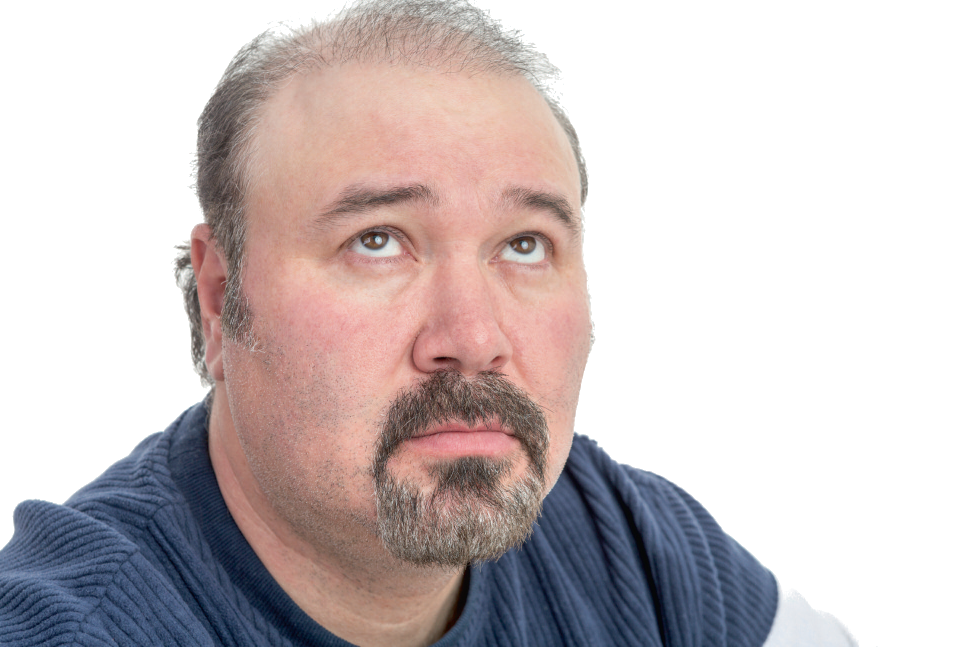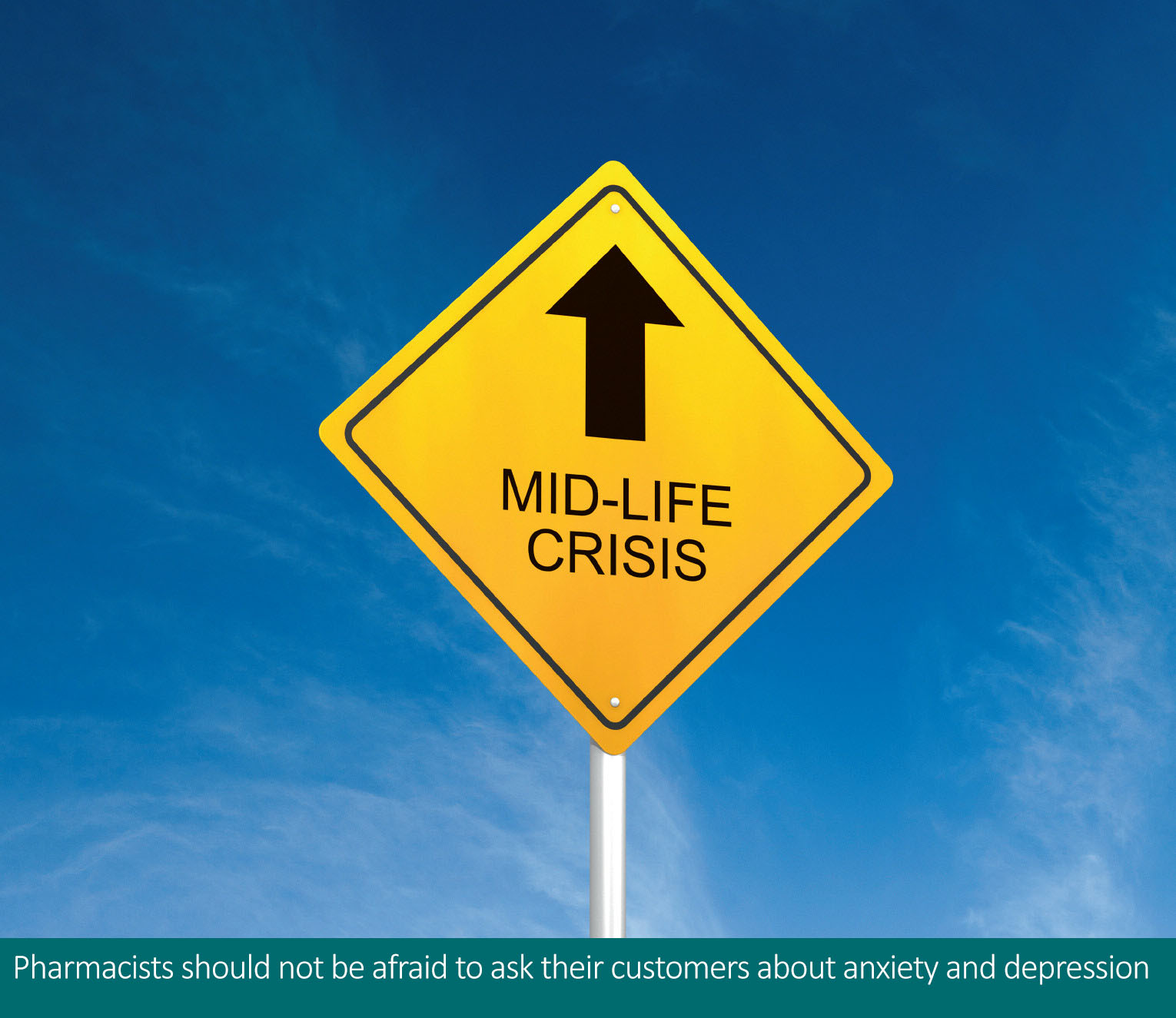Clinical

Mid-life health
In Clinical
Let’s get clinical. Follow the links below to find out more about the latest clinical insight in community pharmacy.Bookmark
Record learning outcomes
The so-called ‘mid-life crisis’ is often a great source of amusement, but is no laughing matter for those going through it as long-term anxiety and depression could be next.
Â
Learning objectives
After reading this feature you should be able to:
- Understand what is really meant by a mid-life crisis
- Identify common mid-life ailments
- Explain the importance of offering NHS Health Checks.
Â
 Life begins at 40… or does it? Turning 40 years of age, or in some cases 50, is often a time of transition, particularly in terms of physical and emotional health. While some people say they feel in the prime of their life at this age, others struggle with worries about getting older.
Life begins at 40… or does it? Turning 40 years of age, or in some cases 50, is often a time of transition, particularly in terms of physical and emotional health. While some people say they feel in the prime of their life at this age, others struggle with worries about getting older.
This age group is often known as the ‘sandwich generation’ because they can be juggling the demands of both children and ageing parents, while also working and maintaining a home. Significant life-changing events, such as divorce and bereavement, can take their toll at this time of life. The latest divorce data from the Office for National Statistics reveals that the average age at divorce is 45 years for men and 42 for women.
“Crises can occur at any stage in life,†says Dr Paul McLaren, consultant psychiatrist at the Priory’s Hospital in Kent, “but this is probably the stage when responsibilities are reaching their peak with family, work and financial pressures converging. A person’s physical health may be compromised and there is less time for exercise and recreation to buffer stress. And mortality starts to loom.â€
Crisis point
Common triggers for a mid-life crisis include redundancy, divorce, bereavement or children moving out of the family home. Figures from the Health and Social Care Information Centre (HSCIC) for the 12 months to November 2013 reveal that the commonest age group for male anxiety admissions was 45-49 years, with stress admissions highest in men aged 40-44 years.
“Priorities do change as people reach their 40s,†says Dr McLaren. “Stresses mount and options start to evaporate. Most of us are set on our career path by this age and, as time goes on, it gets harder to realise and even conceive of alternatives. Having options is an important strategy for managing stress, but we may lose this as we enter middle age.
“I see a lot of men in particular who have previously managed stress through sport and physical exertion. A combination of less time and encroaching commitments means their exercise slips and, with it, an important buffer against stress. This change often takes place just when the demands of mid-life are growing.â€
Traditionally the mid-life crisis is seen as a male problem, yet many women experience emotional turmoil as they reach life’s halfway stage. In the 10 years leading up to the menopause, women’s hormonal fluctuations can trigger mood swings, anxiety and depression.
“My hunch is that something like 20 per cent of women will experience at least a mild mid-life crisis,†says Dr Derek Milne, associate clinical lecturer at the school of psychology at Newcastle University, and author of ‘Coping with a Midlife Crisis’ (Sheldon Press, 2004). “The evidence is there – cosmetic surgery, divorce, depression and starting afresh. In our culture, it strikes me that women are less likely to report it or ‘act out’ in such extravagant/dramatic ways as men.â€
Struggling to cope
Everyone has a different way of coping with mid-life worries. Some people start to feel restless, trying to turn back time by buying younger-looking clothing or having cosmetic surgery. Others may have an urge to escape, leaving relationships and jobs.
Some people go on a shopping spree, attempting to fill perceived gaps in their life with a new car or the latest technology. “To family and friends, these things seem out of character, but the ‘sufferer’ may well lack insight or deny any change, or find other explanations,†says Dr Milne.
For some people, mid-life becomes a time for damaging or reckless behaviour – a second adolescence. In May this year, Drinkaware revealed that around 3.4 million middle-aged people are the nation’s hidden drinkers.
The ‘Drinkaware Monitor: a survey of drinking behaviours and attitudes in the UK’ found that 45 to 64-year-olds are more likely than 18 to 24-year-olds to drink to increasing or higher risk levels. While most say they are not getting drunk, these middle-aged drinkers are in fact drinking alcohol at levels associated with serious health problems, including liver disease and cancer.
Research suggests that poor lifestyle choices in mid-life can have important knock-on effects on health later on. Ongoing emotional stress can trigger other health issues, such as high blood pressure, insomnia, a loss of libido and, in men, erectile dysfunction.
Common mid-life ailments
Many health problems can surface for the first time as people reach their 40s and 50s. Although these are often seen as a natural part of getting older, they shouldn’t be ignored as help and treatments are readily available.
Bladder weakness
According to TENA, one in three women over 40 years of age will experience bladder weakness, compared to one in four men in the same age group. In women, bladder weakness is often related to hormonal changes, such as the menopause, or may be associated with physical changes after one or multiple pregnancies. In men, urine leakage may be due to a urinary tract infection, prostatitis or constipation.
Most people are too embarrassed to seek help, but it is important to establish the cause. Pharmacy customers can use incontinence pads and pants, with various levels of absorbency, to combat ‘accidents’ but if urine leakage is an ongoing problem, they should consult their GP. They may be referred to a NHS Continence Clinic for specialist advice from a continence adviser (usually a nurse) and a specialist continence physiotherapist.
Hair loss
 Male pattern baldness affects around half of all men by the age of 50 years, and most already have some degree of hair loss by their late 30s. This form of baldness causes a receding hairline, followed by thinning of the hair on the crown and temples. Female pattern baldness doesn’t tend to cause bald patches, but women may notice an overall thinning of the hair on their crown.
Male pattern baldness affects around half of all men by the age of 50 years, and most already have some degree of hair loss by their late 30s. This form of baldness causes a receding hairline, followed by thinning of the hair on the crown and temples. Female pattern baldness doesn’t tend to cause bald patches, but women may notice an overall thinning of the hair on their crown.
Hair loss in women is sometimes triggered by sudden or excessive weight loss, low iron levels, poor diet or stress, but it is also associated with the menopause or thyroid problems. Hair loss at any age can lead to a lack of self-confidence and have a significant emotional impact. Customers should be advised to see their GP if they have any concerns.
Over-the-counter topical minoxidil may help to stop or slow down hair loss in both men and women. In some cases, it may thicken the existing hair and even lead to regrowth. Women generally respond better to minoxidil than men. Minoxidil needs to be used for several months before any effect is seen and any regrowth will usually fall out two months after the treatment is stopped.
Men can also ask their GP for a private prescription for finasteride tablets. As with minoxidil, finasteride needs to be taken continuously to have an effect and any benefits stop once the treatment is discontinued.
Customers can also buy hair thickening products, as well as some nutritional supplements that claim to improve the condition of hair. However many of these are not backed by clinical research.
Bone health
From around the age of 35 years, most people’s bone mass gradually declines. An excessive loss of bone tissue can lead to osteoporosis and an increased risk of bone fractures, especially in later life. According to the National Osteoporosis Society, one in two women and one in five men over 50 years are expected to break a bone during their lifetime.
Women are particularly susceptible once their oestrogen levels fall around the time of the menopause. There are many ways to optimise bone health, including eating a healthy diet, taking regular weight-bearing exercise (e.g. walking), cutting down on caffeine and alcohol, and giving up smoking. As a general rule, most adults need 700mg of calcium each day for healthy bones.
Good sources include milk, dairy products, green leafy vegetables, bony fish and dried fruit. Customers who have been diagnosed with osteoporosis may be advised to boost their calcium intake to around 1,000mg a day. Vitamin D (10mcg a day) is important for calcium absorption.
Most vitamin D comes from sunlight exposure, but food sources include margarine, egg yolks, cod liver oil and oily fish such as sardines. Some customers may be at risk of deficiency (e.g. those who eat a poor diet, use sunblock all the time or take corticosteroids) and should ask their GP to check their vitamin D levels.
High cholesterol
According to Heart UK, 60 per cent of adults have high cholesterol, but many of them are unaware as there are no clear signs. Adults between 40 and 75 years of age should have their cholesterol levels checked every five years. Eating a healthy diet (low in saturated fat), not smoking and being physically active are important in helping to keep cholesterol and other blood fats low.
If lifestyle measures fail to work, a GP may prescribe statins, taking into account the benefits and risks for that particular person. Statins are usually offered to people who have been diagnosed with a form of cardiovascular disease or whose family history suggests that they are likely to develop cardiovascular disease at some point over the next 10 years.
Joint pain
Joint pain is usually associated with an injury or arthritis. Osteoarthritis (‘wear and tear’) can develop for the first time in people over 45 years, especially those who are overweight or who have had serious injuries to their joints in the past. It can affect any part of the body but particularly the knees, hips and/or small joints in the hands.
The main symptoms are joint pain and stiffness that comes and goes. Mild symptoms can usually be managed with simple measures, including regular exercise, maintaining a healthy weight and wearing supportive footwear. Many people with osteoarthritis also benefit from oral analgesics (e.g. paracetamol) and/or topical analgesics and a structured exercise programme with a physiotherapist to support and strengthen the affected joints.
Menopausal symptoms
The menopause (when monthly periods stop) strikes women at an average age of 52 years. In the 10 years leading up to this time (the peri-menopause), women may experience a range of symptoms, including hot flushes and night sweats, aches and pains, vaginal dryness, insomnia and mood swings. Many women don’t seek medical advice, preferring to use complementary therapies, dietary supplements and lifestyle measures to ease their symptoms.
There is increasing evidence that phytoestrogens (e.g. soya isoflavones or red clover supplements) can reduce the frequency and severity of hot flushes and night sweats. Hormone replacement therapy (HRT) – oral or topical – is the first-line prescribed treatment for troublesome menopausal symptoms.
Other prescribed medicines are available as an alternative if HRT isn’t suitable. Over-the-counter vaginal lubricants can sometimes ease vaginal dryness.
Â
The National Institute for Health and Clinical Excellence (NICE) is currently developing guidelines to give people the best information about how to stay healthy in their middle years. The draft guidelines, which were under consultation in summer 2014, recommend that healthcare professionals should encourage people to stop smoking and help them to become more physically active, reduce their alcohol consumption, improve their diet and, where necessary, maintain a healthy weight.
The NHS Health Check was launched in 2009 for people between 40 and 74 years of age, to assess and reduce their risk of developing common conditions, such as type 2 diabetes, heart disease, high blood pressure, kidney disease and stroke. “Some people don’t think they need to be checked as they feel fine,†says Jamie Waterall, national lead for the NHS Health Check programme, Public Health England, “but we know that high blood pressure and cholesterol often have no symptoms, so pharmacists should encourage patients to get checked when invited.
“After patients receive their results from a healthcare practitioner, pharmacists can give follow-up advice on living a healthy lifestyle and managing any potential risk factors. It is never too late to make simple changes which could make a big difference to the lives over those over 40.â€
Improving mental health
 Many adults feel unhappy, depressed, stressed or anxious from time to time. There are many ways to combat a low mood and the most effective approach varies from person to person. Some people find that being more active helps, so they take up a new sport or relaxing pastime such as yoga.
Many adults feel unhappy, depressed, stressed or anxious from time to time. There are many ways to combat a low mood and the most effective approach varies from person to person. Some people find that being more active helps, so they take up a new sport or relaxing pastime such as yoga.
Others benefit by spending more time with their family and friends, and changing their working hours. “Instead of trying to put the personal clock back by pretending they are 20 years younger by buying a sports car or having a facelift, they should accept the passage of time, appreciate their strengths and wisdom, and make the most of the years ahead,†says Derek Milne. “If faced with a dilemma or crossroads in their life, they should seize the opportunity to re-invent and develop themselves, seeking support and guidance from family and friends.â€
If these feelings become severe or persistent, pharmacy customers should be advised to see their GP. Pharmacists shouldn’t be afraid to ask about mild depression and anxiety, says Dr McLaren. “Most people won’t feel offended and will be rather relieved that someone is listening to them,†he says.
A good ‘screening’ question for depression is: “Is there anything you enjoy?†Anhedonia, or loss of enjoyment, is a reliable indicator of clinical depression. Sleep disturbance lasting more than a few days can also be an early sign.â€
According to Dr McLaren, cognitive behavioural therapy (CBT) is the first-line treatment for mild depression. It helps people deal with their problems in a more positive way. In some areas, CBT is available on the NHS, but waiting lists can be long.
“CBT doesn’t work for everyone, and, if symptoms are persisting despite good talking treatment, patients need to think about antidepressants,†says Dr McLaren. “They also need to think about their lifestyle. Has it contributed to their depression and anxiety? If so, it needs changing.â€
“They should drink less and exercise more. Never underestimate the negative effects of alcohol on depression and anxiety. And they should be hopeful. These conditions are very treatable and the sooner effective treatment is started, the better.â€
In May this year, the Mental Health Foundation (MHF) called for mindfulness to be made available in all areas of the UK. A MHF survey of over 2,000 British adults reported significant numbers of people always or often feeling stressed, anxious and depressed. It found that nearly half of workers struggle to switch off from work, and that nearly two-thirds of people would be likely to take part in activities that reduce stress.
“Mindfulness is one of the most encouraging practices to support good mental health,†says ceo Jenny Edwards CBE. “Mindfulness-based cognitive therapy is recommended by NICE and endorsed in the chief medical officer’s Mental Health report for reducing the risk of recurrent depression, cutting relapse rates in half. However, the evidence to-date is that only a handful of CCGs make mindfulness available in their area.
“We are calling for mindfulness to be available in all areas of the country so that GPs can recommend it and NICE recommendations can be acted upon. We also encourage people to consider mindfulness as a self-help practice.â€
Â
Key facts
- Poor lifestyle choices in mid-life can have important knock-on effects on health later on
- The average age at divorce is 45 years for men and 42 for women
- Mindfulness-based cognitive therapy is recommended by NICE
